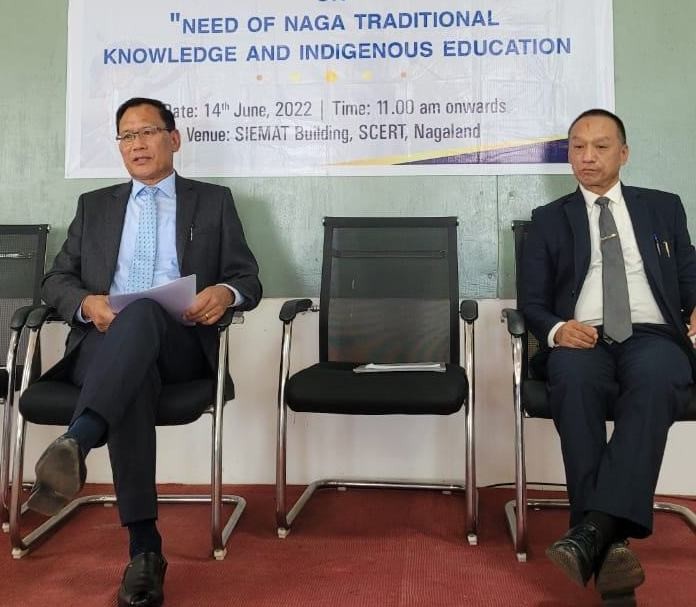Dr Zavise Rume and Vipralhou Kesiezie addressing press conference in Kohima on June 14. (Morung Photo)

Our Correspondent
Kohima | June 14
‘The draft paper for Nagaland’s state own curriculum framework is ready and waiting for state level seminar. As per National Education Policy 2020, for the first time in the country, the respective states have been given responsibility to develop its own state curriculum framework,’ said Dr Zavise Rume, President, Nagaland Education Association while addressing a press conference highlighting on ‘need of Naga traditional knowledge and indigenous education’ on June 14.
Dr Rume said that SCERT Nagaland has been given responsibility to develop its own state curriculum framework, for which 25 different subject matters have been incorporated. Among the many like philosophy of education, aims of education, guidance and counselling, social science, value education, mathematics education, science education etc. many indigenous knowledge matters including agricultural practices and tools also integrated in the new framework.
He said that SCERT will be holding state level seminar where many Naga scholars, educationists, intellectuals will come together to have wider discussion on the new curriculum framework. “People should come and give suggestion/opinions to the making of this state curriculum framework,” he said.
Nagaland SCERT former director, Vipralhou Kesiezie said, ‘the indigenous education strengthens cultural identity and continuity, customary laws and customary governance system. The Nagas have no written records of their history, culture and tradition.’ He said that everything is passed down to us through word of mouth orally. ‘Despite the absence of modern education we have survived thus far based on tested primitive ways of life,’ he added.
‘NEP expected to give equal treatment to all cultures’
The National Education Policy (NEP) says that promotion of Indian art and culture is important not only for the nation but also for the individual. Hence, it should be made a major learning competency for all children, Kesiezie observed. ‘However, when it comes to the actual textual learning contents we find nothing about the diverse cultures of India except the culture of the ruling people who are the majority in India. It is so embarrassing and conspicuous to find that hardly anything is mentioned about the people and their culture of the NE India in the textbooks read by the students in the country. Therefore, it is nothing less than a cultural invasion of the majority over the minorities,’ he said.
As a result of the lopsided policy of the system of education in India, many cultures in India are put into the danger of extinction, he expressed regret.
“The unfortunate alienation is mostly felt by the tribal dominated people in the NE region of India. Therefore, many a times the NEP guidelines are found to be farcical because we find nothing about our tribal cultures when it comes to implementation in the real Classroom situation,” he said.
Kesiezie said that the indigenous tribal cultures, knowledge and their ways of life are in no way inferior to any other culture. The NEP is expected to give equal treatment to all cultures irrespective of size and numbers, he added.
‘All Naga languages are endangered’
Stating that the NEP talks about the medium of instruction through Mother Tongue till elementary level, however, Kesiezie said ‘in the absence of a common language we have adopted English as the medium of instruction at all level of education.’ In the absence of any developed textbooks and learning materials, most of the Naga tribes, Alternative English was introduced. As a result, 80-90% of the Naga children opted Alternative English in lieu of Mother Tongue.
It was in the year 2013, SCERT Nagaland conducted a survey in Kohima on “The changing pattern of languages spoken by the Naga children.” A sample of 1500 school children was collected from both Government and Private schools in Kohima. The findings says that More than 10% can't speak, read and write their own Mother Tongue; They speak Nagamese and English with their parents, friends and teachers; They speak with their own people in Nagamese even in church etc.
“Our children are losing their own identity and getting loss of their own cultural identity,” he said. In the light of the given situation, SCERT has conceptualized the idea of replacing Alternative English and introduced Nagaland Heritage Studies to facilitate in helping the Naga children learning their dialects and cultures.
Today, in Nagaland University, we have a Department of Tenyidie especially for the Tenyidie speaking people, he said. “But why only Tenyidie in NU? Why not all Naga dialects and languages? There should be a Department/Institute of Naga Languages in NU so that the students should be given the opportunity to do research and develop and promote their own languages,” he said.
“All Naga languages are endangered now because the number of speakers is dying with the passing of times. Let us not allow it to die or go extinct,” he urged.



